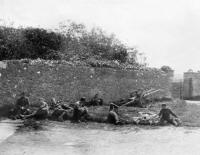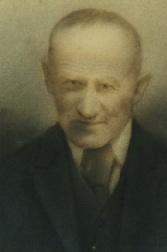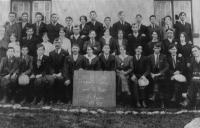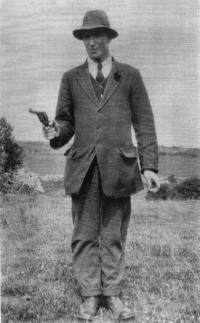Missing in action
Published in 20th-century / Contemporary History, Features, Issue 6 (Nov/Dec 2012), Revolutionary Period 1912-23, Volume 20
British soldiers from a Scottish regiment relaxing in west Clare during the War of Independence. Scottish regiments had a particularly bad reputation in the area. (Clare County Library)
As we approach the centenary of the War of Independence there is a growing interest in the period. To date this interest in County Clare has been focused on relatively well-known events, including ambushes, barracks attacks and the deaths of rebel leaders. This is unsurprising, as these events were commemorated annually from the 1940s onwards, frequently discussed by IRA veterans in later life and widely written about in the local press. One aspect of the conflict in Clare that is far less well known in the county and nationally, however, is the secret execution and burial of British soldiers and members of the RIC. During the War of Independence four serving members of the British forces—Constable Murphy, Private Robertson, Private Chalmers and Private Williams—were secretly buried in unmarked graves in Clare. They died in completely different circumstances. The bodies were most likely hidden out of military necessity by the IRA or in the hope of avoiding reprisals by British forces.

Ned Lynch and his wife Norrie c. 1950s. Lynch, captain of the IRA’s Milltown Malbay company, had confronted Lance-Corporal McPearson and Corporal Buchanan when they came to raid his home at Breffa North on 21 October 1920. The raid resulted in the death of Lynch’s aged father, Charles, and contributed to the later execution of Private Robertson.
Private George Robertson
On 21 October 1920 two British soldiers, Lance-Corporal Alexander McPearson and Corporal Norman Buchanan, had spent the morning drinking in Milltown Malbay in west Clare. Both men were non-commissioned officers of the 2nd Battalion Royal Scots (Lothian Regiment) stationed in the area. That evening, on their way back to barracks, they called to houses in Breffa North, which they burgled on the pretence that they were searching for arms. At 5pm that evening they called to the family home of Ned Lynch, leader of G Company, 4th Battalion of the IRA’s Mid-Clare Brigade. Lynch challenged the pair when they attempted to enter the house:
‘The taller of the two [McPearson] said they were raiding for arms and tried to push past me . . . He carried what I first thought to be a revolver but on closer scrutiny noticed it was a glass one painted black which I knew had been looted sometime previously from Blake’s pub in Milltown. I hit him a heavy punch in the right arm which caused him to drop the “shot of malt”, as the toy gun was known to us locally, and it broke in pieces on the doorstep. Just as this happened one of the neighbours arrived accusing the soldiers of having stolen £10 from him, whereupon the bigger soldier tried to break away. I tripped him and we searched him thoroughly, recovering other articles he had looted but not the money. The second soldier [Buchanan] was less truculent, was also searched but offered no resistance and after receiving directions from my brother made off for the military post.’
 A short time later McPearson returned with a force of British soldiers and RIC, leading them straight to Lynch’s farm. Upon his return McPearson shot dead Charles Lynch, the 70-year-old head of the family. The soldiers then prepared to shoot Charles Lynch’s son John and a neighbour, when an RIC constable named Cooney intervened, saving their lives. The soldiers then set fire to the Lynch family home. Before leaving the area the soldiers shot and wounded John Grady, a local farm labourer, assaulted members of the Lorrie family (who were of ex-British Army stock) and burned several ricks of hay belonging to the Talty, Boland and Moroney families.A week later McPearson was captured by the IRA in the Connolly district, about eight miles east of Milltown Malbay. He was accompanied by a second British soldier, Private George Robertson (service no. 3044395). Both men claimed that they had deserted from the British Army. The IRA Volunteers who had captured the soldiers were apparently unaware of McPearson’s identity and guilt in relation to Charles Lynch’s death. According to IRA veteran Paddy ‘Con’ Mac Mahon, McPearson and his comrade were initially accepted as genuine deserters and were treated quite well: ‘never knowing what they were involved in . . . they kept them in farm houses for some time and they brought them to dances, but there was a guard always with them’. McPearson was being held at Eustace’s house in Lisroe when he escaped on 30 October 1920. According to Ned Lynch, McPearson had tricked his guard, an IRA Volunteer named Hehir, who was ‘a giant of a man, athletically built but much too innocent for the character with whom he was dealing’. Hehir was loading a revolver under the watchful eye of McPearson, who commented that Hehir did not have the proper technique. He generously offered to demonstrate this, and when Hehir handed him the loaded weapon McPearson made his escape without attempting to take Robertson with him.Alarmed at McPearson’s escape, the IRA executed Private Robertson. His body was buried in a bog at Connolly that was owned by Colonel Tottenham, a local unionist, since it was felt that his lands were unlikely to be searched by the British forces. McPearson returned to Connolly the next day, leading a British military search party. He identified the houses in which he had been held captive through marks that he had carved into the furniture with a tobacco knife. At one farm he had carved his initials into the rafters of an outdoor toilet. The houses McPearson identified were burnt in reprisal but the search party was unable to find any trace of Private Robertson, except for his bloodstained uniform cap.
A short time later McPearson returned with a force of British soldiers and RIC, leading them straight to Lynch’s farm. Upon his return McPearson shot dead Charles Lynch, the 70-year-old head of the family. The soldiers then prepared to shoot Charles Lynch’s son John and a neighbour, when an RIC constable named Cooney intervened, saving their lives. The soldiers then set fire to the Lynch family home. Before leaving the area the soldiers shot and wounded John Grady, a local farm labourer, assaulted members of the Lorrie family (who were of ex-British Army stock) and burned several ricks of hay belonging to the Talty, Boland and Moroney families.A week later McPearson was captured by the IRA in the Connolly district, about eight miles east of Milltown Malbay. He was accompanied by a second British soldier, Private George Robertson (service no. 3044395). Both men claimed that they had deserted from the British Army. The IRA Volunteers who had captured the soldiers were apparently unaware of McPearson’s identity and guilt in relation to Charles Lynch’s death. According to IRA veteran Paddy ‘Con’ Mac Mahon, McPearson and his comrade were initially accepted as genuine deserters and were treated quite well: ‘never knowing what they were involved in . . . they kept them in farm houses for some time and they brought them to dances, but there was a guard always with them’. McPearson was being held at Eustace’s house in Lisroe when he escaped on 30 October 1920. According to Ned Lynch, McPearson had tricked his guard, an IRA Volunteer named Hehir, who was ‘a giant of a man, athletically built but much too innocent for the character with whom he was dealing’. Hehir was loading a revolver under the watchful eye of McPearson, who commented that Hehir did not have the proper technique. He generously offered to demonstrate this, and when Hehir handed him the loaded weapon McPearson made his escape without attempting to take Robertson with him.Alarmed at McPearson’s escape, the IRA executed Private Robertson. His body was buried in a bog at Connolly that was owned by Colonel Tottenham, a local unionist, since it was felt that his lands were unlikely to be searched by the British forces. McPearson returned to Connolly the next day, leading a British military search party. He identified the houses in which he had been held captive through marks that he had carved into the furniture with a tobacco knife. At one farm he had carved his initials into the rafters of an outdoor toilet. The houses McPearson identified were burnt in reprisal but the search party was unable to find any trace of Private Robertson, except for his bloodstained uniform cap.

Moy branch of the Gaelic League 1917–18, including IRA officers Séamus Hennessy (inset, posing with a Webley revolver during the Civil War) and Steve Gallagher (front row, third and fourth from the right respectively), who presided over Private Chalmers’s execution and secret burial in June 1921. Tom Tuttle, whose home Private Chalmers had called at shortly before his capture, is in the back row, third from the left. (Colin Hennessy)
Private George Duff Chalmers
Eight months after Private Robertson’s death a second member of the Royal Scots was executed and secretly buried in west Clare. The IRA knew that the British forces were due to serve a court summons on Tom Tuttle, a republican sympathiser who lived at Moughna, Lahinch. It was expected that the RIC would perform this duty; a group of sixteen IRA Volunteers led by Anthony Malone had lain in ambush for them on the appointed date but the RIC failed to turn up. The summons was eventually served on 11 June 1921 by a party of British soldiers from the Royal Scots who had travelled to Moughna in a convoy of four lorries.As they made their return journey, one of the soldiers, Private George Duff Chalmers (service no. 3044605), deliberately dismounted from one of the lorries in the Lavoureen district. The main party continued on without him. According to accounts of the incident still surviving in the area, Private Chalmers was courting a local woman and left the convoy to pay her a visit. A short time after leaving the lorry Chalmers was captured by two members of the IRA. During his interrogation Chalmers refused to give his name. He was subsequently court-martialled by the IRA and sentenced to death. According to the IRA report of the incident, Chalmers was executed on suspicion of being on a mission to gather military intelligence:

Séamus Hennessy, posing with a Webley revolver during the Civil War.
‘A private of the Royal Scots, who dropped off one of four lorries passing through C. Coy area, was captured by two riflemen after a chase. The b[attalio]n staff being satisfied that his object in leaving the lorry was to seek information had him executed on the same date, after getting all the information they could from him. He did not give information of importance.’
Private Chalmers was shot and buried in an unmarked grave at Moy, Lahinch. Given Chalmers’s apparent refusal to reveal his identity to his captors and his membership of the Royal Scots, he may have been mistaken for Lance-Corporal McPearson, Corporal Buchanan or one of the other soldiers involved in the killing of Charles Lynch. Scottish regiments had a particularly bad reputation in the area. In April 1920 a mixed patrol of RIC and British soldiers from the Royal Highland Light Infantry had opened fire on a group of civilians in Milltown Malbay, killing three people. In September 1920, Scottish soldiers had taken part in reprisals following the Rineen ambush, resulting in the deaths of seven people, including two children. It seems likely that had Private Chalmers been a member of a different British army regiment, captured in the same circumstances, he would not have been treated as harshly.
Attempts to retrieve the bodies
During the Truce the IRA’s East Clare Brigade decided to exhume Constable Murphy’s body and return it to the RIC. On 22 October 1921 Constable Murphy’s remains were discovered at the Catholic church in Sixmilebridge by RIC sergeant Martin Turnbull. Murphy’s body had been wrapped in sacking and placed in a new coffin. A plate on the coffin lid read: ‘Daniel A. Murphy. Died 9 March 1921. Aged 23 years. RIP’.During the Civil War the duke of Devonshire began correspondence with Richard Mulcahy in an effort to locate the remains of Robertson, Chalmers and Williams. Since the majority of the IRA Volunteers in Milltown Malbay and Lahinch had taken the republican side during the Civil War, the Free State Army in Clare were unable to glean much information. They were able to confirm to the duke that both Robertson and Chalmers had been executed, and could give the approximate date and location for each. They were unable to locate the grave of either soldier, however, and were forced to admit defeat after concluding that ‘there are a good many bogs in that district; the information is not very definite’. Despite assistance from the farmer who had buried Private Williams at Bunratty, the attempt to retrieve his remains also proved unsuccessful. Free State soldiers spent several days excavating the eastern bank of the Owengarry River at the spot where the farmer had buried Williams’s body. The army officers and medical doctor involved concluded that Williams’s remains had sunk too deep into the riverbank to be recovered.In 1937 the Office of Public Works erected a memorial commemorating Williams in the Old Bunratty churchyard, a short distance away. It is one of the few ‘Kipling memorials’ in Ireland, so called after Kipling’s suggestion that memorials for soldiers whose graves were unknown should bear the inscription from Ecclesiasticus 44.13, ‘Their glory shall not be blotted out’. In the 1950s a group of young men cutting turf at Moy accidentally stumbled across the remains of Private Chalmers. They had been told that there was a British soldier buried in that part of the bog and had been warned not to cut turf there but had dismissed this as an old wives’ tale. When they uncovered part of Private Chalmers’s uniform, they quickly reburied it and went in search of another area in which to foot turf. HI
Pádraig Óg Ó Ruairc is a Ph.D student at the University of Limerick.
Further reading:
F. D’Arcy, Remembering the war dead (Dublin, 2008).Irish Military Archives, A/07304 (correspondence relating to British soldiers missing in Ireland 1919–23).P. Óg Ó Ruairc, Blood on the banner: the republican struggle in Clare (Cork, 2009).
















